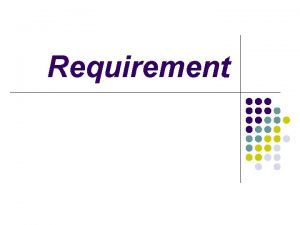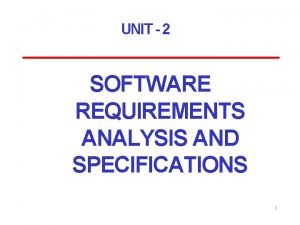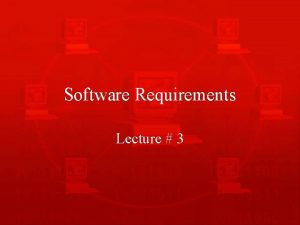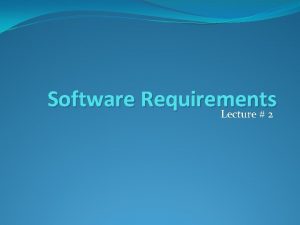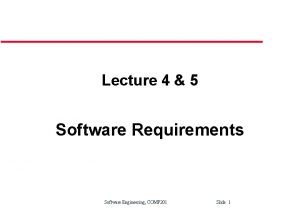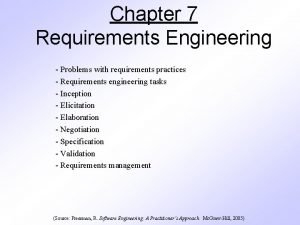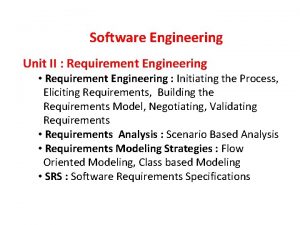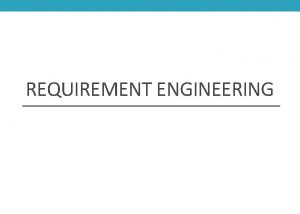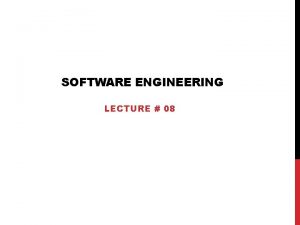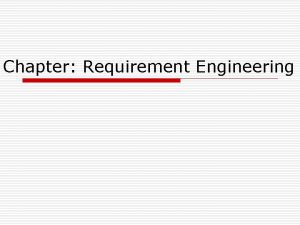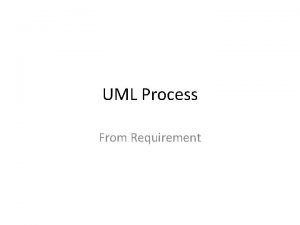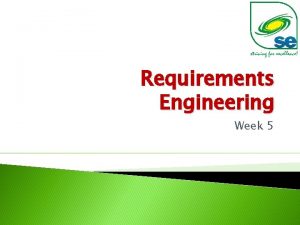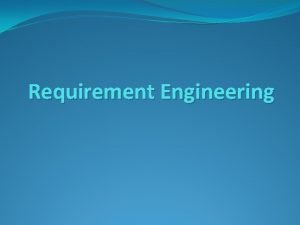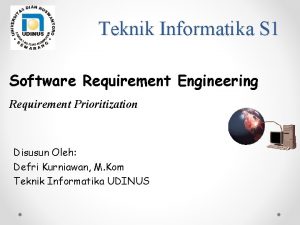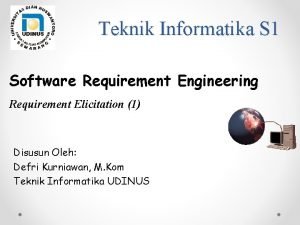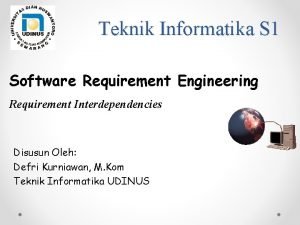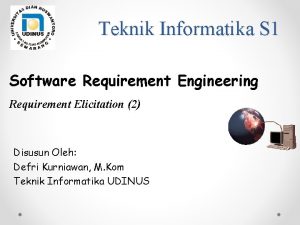Software Requirement Engineering 2 1 Software requirements What













- Slides: 13

Software Requirement Engineering 2. 1 -Software requirements: What, why, and who 1

2 Today’s key points The essential software requirement Requirements from the customer's perspective Good practices for requirements engineering The business analyst

3 Requirements from the customer’s perspective Case 1: Ali: a senior manager at White Pharmaceuticals Ahmed: the manager of White’s IT department

4 Ali: “The system should keep track of all the chemical containers we already have in the stockroom and in laboratories. That way, the chemists can get some chemicals from someone down the hall instead of always buying a new container. This should save us a lot of money. Also, the Health and Safety Department needs to generate government reports on chemical usage and disposal with a lot less work than it takes them today. Can you build this system in time for the compliance audit in five months? ” Ahmed: “I see why this project is important, Ali. But before I can commit to a schedule, we’ll need to understand the requirements for the chemical tracking system. ” Ali: “What do you mean? I just told you my requirements. ” Ahmed: “Actually, you described some general business objectives for the project. That doesn’t give me enough information to know what software to build or how long it might take. I’d like to have one of our business analysts work with some users to understand their needs for the system. ”

5 Ali: “The chemists are busy people. They don’t have time to nail down every detail before you can start programming. Can’t your people figure out what to build? ” Ahmed : “If we just make our best guess at what the users need to do with the system, we can’t do a good job. We’re software developers, not chemists. I’ve learned that if we don’t take the time to understand the problem, nobody is happy with the results. ” Ali: “We don’t have time for all that. I gave you my requirements. Now just build the system, please. Keep me posted on your progress. ”

6 Problem: Customers who request a new system often don’t understand the importance of obtaining input from actual users of the proposed system as well as other stakeholders.

7 The expectation gap Without adequate customer involvement, the inescapable outcome at the end of the project is an expectation gap, a gulf between what customers really need and what developers deliver based on what they heard at the beginning of the project (Wiegers 1996).

8 Who is the customer? Stakeholders A stakeholder is a person, group, or organization that is actively involved in a project, is affected by its process or outcome, or can influence its process or outcome. Stakeholders can be internal or external to the project team and to the developing organization. Stakeholder analysis is an important part of requirements development (Smith 2000; Wiegers 2007; IIBA 2009).

9

10 Customers are a subset of stakeholders. A customer is an individual or organization that derives either direct or indirect benefit from a product Software customers could request, pay for, select, specify, use, or receive the output generated by a software product. Examples: Figure 2 -2 include the direct user, indirect user, executive sponsor, procurement staff, and acquirer. Some stakeholders are not customers, such as legal staff, compliance auditors, suppliers, contractors, and venture capitalists. User requirements should come from people who will actually use the product, either directly or indirectly. These users (often called end users) are a subset of customers. Direct users will operate the product hands-on. Indirect users might receive outputs from the system without touching it themselves,

11 The customer-development partnership An excellent software product results from a well-executed design based on excellent requirements. Excellent requirements result from effective collaboration between developers and customers (in particular, actual users)—a partnership. The business analyst typically is the point person who has to forge this collaborative partnership.

12 Recommended Requirements Bill of Rights and Responsibilities for SC

13
 Contoh user requirement dan system requirement
Contoh user requirement dan system requirement Requirement validation in software engineering
Requirement validation in software engineering Requirement analysis diagram
Requirement analysis diagram Software engineering lecture notes
Software engineering lecture notes Requirement analysis steps in software engineering
Requirement analysis steps in software engineering Requirement analysis plan
Requirement analysis plan Inverse requirements
Inverse requirements Inverse requirements in software engineering
Inverse requirements in software engineering Form-based specifications
Form-based specifications Requirements discovery techniques in software engineering
Requirements discovery techniques in software engineering Dfd
Dfd What is domain requirements in software engineering
What is domain requirements in software engineering Comp requirements
Comp requirements 7 tasks of requirement engineering
7 tasks of requirement engineering
